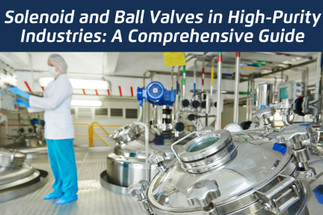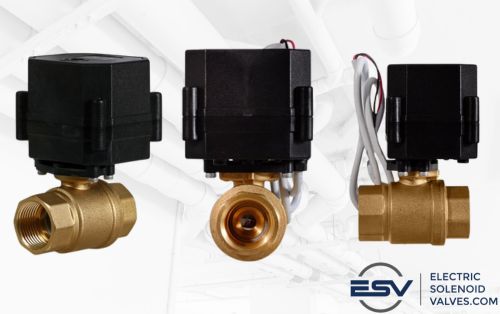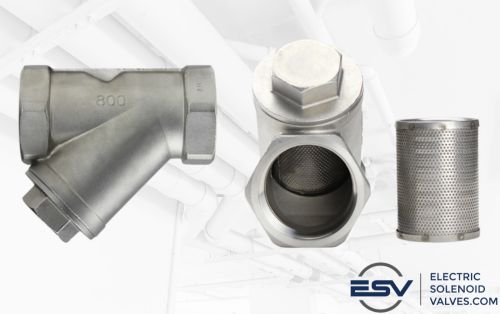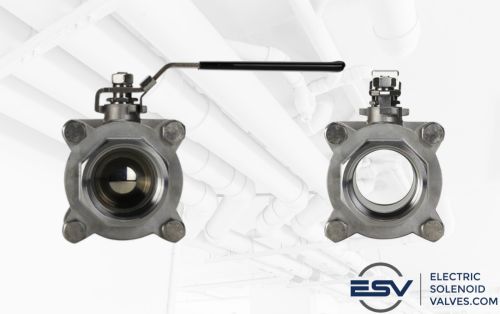Dec 27th 2023
Solenoid and Ball Valves in High-Purity Industries: A Comprehensive Guide
High-purity fluid applications span different industries - from food processing systems and pharmaceutical manufacturing to semiconductor or aviation parts production facilities. These operations have a strict demand for cleanliness, requiring processes to retain substantial purity of raw materials, products in process, and even finished goods. The slightest presence of contaminants could pose significant quality issues or defects to the final product.
How does the demand for high purity affect valve selection in such industrial applications? This blog discusses the possibility and design considerations for electronic controlled solenoid and ball valves in high-purity fluid applications. We will explore material selection and compare the performance characteristics of both valve categories.
Brass electric ball valves which can be used for less aggressive high-purity fluid control
Understanding High Purity Valves
High-purity valves are a unique category of fluid control devices that help maintain contaminant-free industrial environments when conveying service fluids. They help mitigate the harmful effects of impurities, preventing the transfer or accumulation of even the slightest traces of impurities.
While solenoid and ball valves qualify as high-purity valves, there are some constructions or design features that the valves must meet. Failure to incorporate some of these design and manufacturing features may limit the applicability of these valves in high-purity applications. For instance, valves fabricated from reactive alloys are unsuitable for high-purity applications experiencing elevated temperature and pressure variations.
High-purity solenoid and ball valves have the following features, making them ideal for contaminant-free fluid applications:
- Solenoid valves and electrically actuated ball valves precisely regulate fluid flow through industrial piping systems. Their high precision levels mean the valves can respond to flow control requirements and quickly open or close. This quick responsiveness (quick and predictable shut-off) is crucial for preventing cross-contamination or media leakages, which may negatively impact product quality or process safety.
- High-purity solenoid and ball valves use high-quality materials resistant to chemical corrosion and frictional abrasion by service media. The fabrication materials are also sterile to cleaning agents used to rid the system of impurities that may accumulate around valves over time.
- High-purity solenoid and ball valves exhibit impeccable integrity and reliable functionality levels over the piping system's designed capacity and cycling requirements. These valves will provide reliable media shut-off, precise directional or volumetric fluid control, and leakage prevention despite changing operating temperatures and pressure range. Achieving these performance characteristics condenses to proper valve sizing, correct calibration, proper material selection and utilizing the appropriate valve control systems.
- High-purity solenoid and ball valves have smooth internal surfaces. The ports and valve trims are optimized to ensure the flow control devices leave no room for accumulation of particles in and around the valves. Rough surfaces and valve trims are hotspots for contamination and permit the collection of adhesive particles or microorganisms, exacerbating media contamination and negatively impacting the integrity of high-purity fluids and applications.
- Solenoid and ball valves have simple internal designs. These design features mean the valves have minimal dead spaces. A dead space is an area within the valve body where contaminants or service fluids stagnate or get trapped. Huge dead spaces create suitable conditions for accumulating debris or other foreign matter that propagates media contamination.
Sources of Contaminants in Industrial Applications
Before exploring the benefits of solenoid and ball valves in high-purity fluid applications, it is crucial to understand the different types and sources of contaminants in industrial applications. Different contaminant types can enter an industrial fluid application, each having specific consequences on process integrity, safety, and reliability. These contaminants include:
- Particulate matter such as dust and debris
- Chemical contaminants, which could be by-products of media corrosion or residues from pipeline cleaning and sterilization agents
- Microorganisms like bacteria or fungi. These can get to industrial piping systems due to poor sanitation or improper hygiene practices around high-purity applications.
- Sediments from worn-out valve components. Valve components like seals and gaskets deteriorate over time due to media abrasion and chemical corrosion. The damaged valve components enter the piping systems, contaminating service fluids.
- Cross-contamination occurs when different fluids mix or fail to separate at undesired intervals. Cross-contamination can also happen when valves fail, allowing impurities to return to the piping system.
- Airborne vapors and gases may ingress piping systems and dissolve in service fluids.
- Foreign materials may enter piping systems during installation and routine maintenance of process valves.
In addition to the valves themselves, auxiliary components like Y-strainers can play a crucial role in maintaining the purity of fluids. Y-strainers are specifically designed to capture particulate matter such as dust and debris, preventing them from entering and contaminating the system.
Capture dust and debris effectively in high-purity environments with Y-strainers
These devices are especially beneficial in high-purity applications, as they work in tandem with solenoid and ball valves to ensure the integrity and cleanliness of the fluid flow. Their inclusion in the system design is a testament to a comprehensive approach required to maintain high standards of purity in industrial environments. For more information on Y-strainers and their applications, visit our Y-Strainers Page.
Benefits of high-purity valves and how they mitigate contamination
Preventing the ingress of contaminants in sensitive industrial fluid flow applications is essential for controlling operational costs, streamlining quality control and enhancing compliance with safety and industry standards. Utilizing solenoid valves and ball valves for such applications provides the first line of defense against these contaminants. The broad benefits of high-purity solenoid and ball valves are:
- Effective defense against contamination. These valves prevent impurities from entering sensitive pipelines. Both solenoid and actuated ball valves have quick response times and can effectively block contaminants from entering sensitive process pipelines and equipment.
- High-purity solenoid and ball valves enhance a company’s compliance with quality and regulatory standards. The design and fabrication of these valves follow strict industry standards. The ability of these valves to meet desired flow control and performance characteristics means companies in sensitive operations like pharmaceutical manufacturing or food processing industries can meet regulatory standards as specified by bodies like the US Food and Drug Administration (FDA).
- Solenoid and ball valves in high-purity applications contribute to better product quality control and integrity. The valves ensure service fluids retain the desired quality standards as they move through piping systems. It implies the end products, whether pharmaceutical drugs, aviation components or electronic components, will achieve the desired quality standards.
- High-purity solenoid and ball valves enhance operational efficiency, providing smooth and uninterrupted fluid flow through complex piping systems. Their smooth internal surfaces prevent conditions like turbulence around valves, which may affect the precision and overall efficiency of pipeline equipment like pumps.
- Utilizing solenoid and ball valves for high-purity industrial applications ensures seamless maintenance, reducing process downtime and related costs. These valves require fewer maintenance interventions throughout their service lives. They are also designed for versatile fluid handling, exhibiting excellent defenses against chemical and media corrosion.
Material Selection for Solenoid and Ball Valves in High-Purity Applications
The performance of solenoid and ball valves in high-purity fluid applications is highly dependent on the choice of fabrication materials. These valves utilize advanced engineering materials, which may undergo additional surface treatment techniques to meet corrosion resistance and enhance their internal smoothness.
The optimal performance characteristics of these valves vary depending on their utilization areas. For example, the semiconductor manufacturing industry deals with viscous service fluids. Solenoid and ball valves for such applications require better defense mechanisms against media corrosion and abrasion compared to those valves for regulating the flow of purified water in a food processing facility.
Within the realm of ball valves, 3-way electric ball valves stand out for their adaptability and efficiency in high-purity environments. These valves are designed to offer precise control over the direction of fluid flow, making them an invaluable asset in applications where fluid routing is complex. The construction and material choices for 3-way electric ball valves are aligned with the stringent demands of high-purity applications, ensuring they perform optimally in various industrial settings. Their robust design and operational flexibility make them a preferred choice for many high-purity applications. Discover more about the features and benefits of these valves on our 3-Way Electric Ball Valves Page.
Key Considerations in Material Selection
How does the typical material selection process for high-purity solenoid and ball valves look? The material selection process considers the following key features:
- Corrosion resistance - High-purity valves must resist media and environmental corrosion in an industrial application. Service fluids corrode internal valve surfaces over time. It is because of the viscous properties of different service fluids. The level of corrosion depends on how fast the fluids move past the valves. A high-purity valve should guarantee excellent corrosion resistance characteristics irrespective of the prevailing flow conditions.
- Chemical compatibility - Some service fluids have chemically active components. The chemicals can react with the valve materials, compromising the reliability of high-purity valves. Some chemicals can leach through the valve materials, finding a way into the fluid stream. These chemicals and by-products of the chemical reactions are detrimental to the integrity of high-purity fluid applications. One must ensure that solenoid or ball valves chosen for high-purity applications have the right blend of valve fabrication materials. Materials should be unreactive with the service media or compatible with the chemical properties and compositions of the service fluids.
- Non-contaminating qualities of fabrication materials - Valve materials for contamination-sensitive industrial applications should not contain any traces of contaminating materials or particles. Some fabrication materials may contain small traces of impurities which may leach over time. The contaminants may also have lower chemical resistance properties, disintegrating into small particles over time and contaminating the service fluids. Valve materials, pure or alloy, must be non-contaminating over the system’s operating range.
- Temperature and pressure endurance of valve materials - High-purity fluid applications can be subjected to elevated process temperatures and pressure. Frequently changing these operating conditions changes the physical properties of valve fabrication materials. The materials expand and contract as they respond to changes in fluid flow conditions. The choice of valve fabrication materials should ensure the valves do not expand or contract beyond a predetermined limit. Some valves can deform due to overpressure, with some losing their sealing efficiencies. Such deformations due to lower temperature and pressure endurance create perfect conditions for introducing impurities into sensitive piping sections.
Material Quality and Performance Criteria
Material quality and performance features affect the selection criteria for valve bodies and sealing materials. Concentrating on the perfect choice for the valve body and disregarding due diligence when choosing sealing materials reduces valve effectiveness, increasing the chances of media contamination a few moments after putting a valve into service.
Considering the various intricacies around fabrication materials for high-purity industrial valves, it is crucial to consult experts before purchasing valves. Our consultants at Electric Solenoid Valves can help you work through the process and provide enough guidance to ensure you get value for your money and acquire high-quality solenoid and ball valves.
Common Materials for High-Purity Valves
Which are the common manufacturing materials for high-purity solenoid and ball valves and which characteristics do they possess?
- Stainless steel 316L - is a corrosion-resistant material containing traces of elements like molybdenum, chromium, and nickel. These elements increase the pressure and temperature endurance of steel. Stainless steel 316L is also resistant to different chemicals, making it suitable for chemically active industrial environments. Valves manufactured from stainless steel 316L perform well in pipelines conveying acidic and chloride-rich media. Stainless steel 316L is also unreactive to various pharmaceutical and food-grade substances.
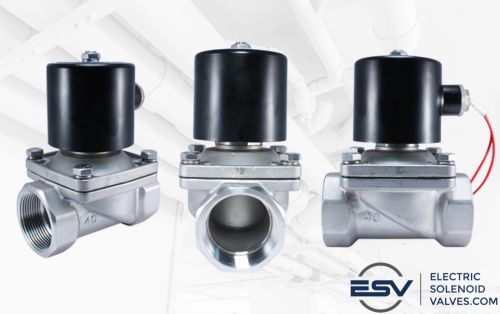
Stainless steel electric solenoid valve
- Hastelloy - is a nickel alloy exhibiting excellent corrosion resistance and can accommodate high process temperatures and pressure. This material provides adequate defenses against aggressive media corrosion, exhibiting high stability at elevated temperatures. Hastelloy has good resistance against pitting and crevice corrosion affecting valves regulating viscous service fluids. This material is vital for fabricating valves for servicing halides and alkaline and acidic media.
- Polytetrafluoroethylene (PTFE) - PTFE, aka Teflon, is a non-metallic valve fabrication material with excellent physical and chemical properties. This material is critical for fabricating valve seals. It has low friction coefficients and remarkable chemical resistance properties. PTFE remains stable over a wide temperature range. It is chemically inert (cannot react with various service media), making it appropriate for multiple high-purity fluid applications.
- Polyvinylidene Fluoride (PVDF) - is a non-metallic valve material with excellent heat, abrasion, and impact resistance properties. It is chemically inert and maintains stability under high-temperature conditions associated with some high-purity applications. PVDF is also UV resistant, making it suitable for fluid applications with exposure to ultraviolet light.
- Brass - is a material for fabricating high-purity valves for less aggressive applications. Brass valves have modest corrosion resistance. This material is unsuitable for corrosive or acidic flow applications.
Valve fabrication materials may require additional treatment methods to improve their physical characteristics and enhance their performance in different high-purity applications. High-purity valves are manufactured and assembled in control environments to minimize the introduction of contaminants. They also undergo multiple post-manufacturing and assembly tests.
These tests are critical for verifying the integrity and structural strengths of valves. Valve testing involves different non-destructive testing (NDT), which unearths surface defects that can be points of contamination in fluid applications. High-purity solenoid and ball valves are also subject to pressure and leak tests. These tests validate the integrity and suitability of valves for contamination-sensitive fluid applications.
Advanced Material Treatment Processes
Here are some vital material treatment processes to maximize the physical and chemical-resistance properties for high-purity fluid applications.
- Electropolishing - Is an electrochemical process for removing materials from the surfaces of a valve. The treatment process removes surface materials selectively. Electropolishing is vital for achieving smooth and polished valve surfaces. Smooth finishes eliminate rough surfaces, which permit contaminants to accumulate. This surface treatment method also enhances the corrosion resistance capabilities of high-purity solenoid and ball valves.
- Passivation - Is a popular material treatment method for steel-based high-purity valves. The process removes any traces of iron and other contaminants on the valve surface. The removal of these elements improves valve corrosion resistance capabilities.
Comparative Analysis of Solenoid and Ball Valves in High-Purity Applications
Solenoid and ball valves are perfect candidates for high-purity fluid applications. Each valve category has unique performance characteristics for fluid control in different situations. The comparative analysis of solenoid and ball valves in high-purity applications evaluates:
- Reliability
- Precision and accuracy
- Response time
Reliability
Solenoid valves feature a few moving parts. The few moving parts enhance their reliability and are less prone to mechanical failures. These valves have a durable lifespan and less demand for maintenance.
One thing that compromises the reliability of solenoid valves is elevated heat in operating environments. Solenoid valves without proper heat elimination mechanisms are susceptible to coils overheating in high-temperature environments.
Ball valves similarly have high-reliability scores. They feature robust internal constructions and have few internal components. They are less likely to encounter mechanical breakdowns. Ball valves are designed to provide tight seals, preventing media leakage and fugitive emissions.
Considering reliability, solenoid valves are more appropriate for high-purity applications where on/off fluid control is desired. It involves applications like fluid dispensing systems in pharmaceutical manufacturing. Such applications demand quick and precise fluid dispensation at different intervals.
Ball valves are suitable for aggressive high-purity environments. They provide tight shut-off and can regulate the flow of viscous fluids. Ball valves are preferable for semiconductor manufacturing as they can effectively handle viscous fluid flow.
Precision and Accuracy
Solenoid and ball valves can provide precise flow control in different applications. Solenoid valves permit proportional fluid control, enabling flow rate variation from time to time. They are suitable for on/off switching in diverse high-purity applications.
Ball valves provide accurate and precise fluid controls required for high-purity applications. However, manual ball valves do not have the same accuracy for flow modulation as solenoid valves. Electrically actuated ball valves have better accuracy but are lower than solenoid valves.
Image depicting a closed and open 1 1/4" manual ball valve
Solenoid valves are more suitable for quick and accurate fluid control in analytical devices for sampling liquids along a processing or manufacturing line. A ball valve will be more precise for handling gaseous media regulation on the same line.
An important variation within the solenoid valve category is the 3-way solenoid valve. These valves are particularly advantageous in high-purity applications for their ability to control fluid flow with great precision in multiple directions. This versatility makes them ideal for complex fluid handling systems where directing flow accurately is crucial. 3-way solenoid valves offer a level of control that is essential in maintaining the high standards of purity and efficiency required in sensitive industrial processes. For a closer look at our range of 3-way solenoid valves and their specific applications, explore our 3-Way Solenoid Valves Page.
Response Time
Solenoid valves respond faster to changes in fluid flow conditions. They have quick response times and can operate in milliseconds. The response times for solenoid valves vary depending on the sizes of the solenoid.
Ball valves have quick response times too. The ball rotates 90 degrees to move from open to close position. This transition takes a few milliseconds. Large ball valves may have slower responsiveness than smaller ones as they overcome more inertia forces.
Solenoid valves are ideal for high-purity applications where rapid and precise on/off fluid control is required, like filling food and beverages at the end of a food production line. Ball valves are viable for industrial applications where quick responsiveness is necessary but not very critical.
Best Practices for Maintenance and Operation of High Purity Solenoid and Ball Valves
The longevity and performance of solenoid and ball valves in high-purity industrial applications depends on how well one installs, maintains and utilizes them. Some practices can accelerate the wear and tear of these valves, increasing their media contamination levels. Some best practices to consider when handling these valves include:
- Follow manufacturer specifications when installing high-purity valves. Ensure the installation environment is clean and free from dirt.
- Regularly test and inspect high-purity valves. Inspections expose signs of valve failures, helping companies to replace aging or problematic valves.
- Develop and regularly update a material compatibility chart for high-purity solenoid and ball valves to align with changes in the compositions of service fluids.
- Implement a cleaning-in-place (CIP) and sterilization program to remove contaminants from the high-purity piping system.
- Develop, depending on the available budgets, a preventive or predictive maintenance program to implement maintenance measures based on their usage cycles.
- Design redundant systems for high-purity solenoid and ball valves. It reduces downtime when emergency failures occur.
Where possible, utilize modular designs for high-purity valves. Modular valve designs allow you to replace specific damaged components instead of the whole valve. Valves can also feature self-draining ports for easy cleaning.
Future Trends for Solenoid and Ball Valves for High-Purity Fluid Applications
Technological advancements continue to change valve control systems with real-time access to valve performance data, providing better visibility over high-purity industrial systems. Some trends to watch in high-purity valve operations include:
- Integrating sensors and communication protocols to enhance smart valve technology for more data-driven predictive maintenance and visualization of high-purity valve performance metrics.
- Innovations in material coating technology will improve the production of corrosion-resistant valves, enhancing contamination mitigation measures in aggressive high-purity fluid applications.
- Additive manufacturing will revolutionize the production of complex valve geometries. It will reduce high-purity valve production costs and improve the customization of valve designs for specific high-purity applications.
- More focus on energy-efficient valve designs will lower energy costs and enhance fluid flow actuation systems.
- Blockchain technology will enhance compliance management when dealing with high-purity valves. Industry operators can trace quality management and controls from manufacturing to utilizing valves.
Final Words
The demand for high-purity valves is poised to increase as companies globally ramp up operations in food and beverage, pharmaceutical and semiconductor manufacturing. Solenoid and ball valves have proven pivotal in regular fluid applications and are viable solutions for high-purity fluid applications.
These valves are available in different sizes and designs to meet the performance requirements of different facilities. Electric Solenoid Valves has a rich catalog of high-quality solenoid and ball valves to address flow control gaps in different industries. Consult our team, and they will advise on the most suitable product for your high-purity fluid application.

